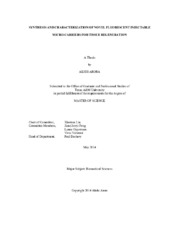| dc.description.abstract | Specific problem: Our previous study showed that the nanofibrous poly-l-lactic acid (NF-PLLA) microspheres are excellent cell carriers for tissue regeneration. However, these injectable microspheres are not fluorescent biomaterials. Incorporation of fluorescent chromophore into NF-PLLA microspheres will allow imaging for proper delivery of scaffold at the specified site and monitor time related degradation in the scaffold, and tissue regeneration by live fluorescent imaging, without the need of sacrificing the animals or undertaking elaborate histological procedures. To date, there is no report on the synthesis of fluorescent PLLA. In this research, we aim to develop an injectable fluorescent PLLA scaffold for tissue regeneration by using Eosin Y (EY) fluorophore as initiator.
Method: The fluorescent polymer (PLLA-EY) was synthesized by ring-opening polymerization (ROP) of l-lactide by bulk polymerization method using stannous octoate Sn(Oct)_(2) catalyst and EY fluorophore initiator, at four different monomer/initiator (M/I) molar ratios (20:1,100:1,200:1,400:1). The PLLA-EY polymer was characterized by FT-IR, UV-visible spectrophotometry and molecular weight (MW). The smooth walled (SW) and nanofibrous (NF) microspheres were fabricated from PLLA-EY 200:1 and 400:1 from methods previously described. These were characterized by SEM, confocal, in vitro biodegradation in PBS (pH change and SEM) and cytotoxicity testing (MTS assay) on dental pulp stem cells (DPSCs).
Results: EY initiator generated free radicals causing ROP of l-lactide and incorporation of EY in the PLLA polymer chain. FT-IR and UV-vis spectra confirmed incorporation of EY in the polymer. Increasing the M/I ratio increased MW of PLLA-EY polymer. Microspheres formed from PLLA-EY were auto-fluorescent and increasing the polymer MW resulted in more well-defined nanofibers. Both short term (7d) and long term (21d) cytotoxicity results confirmed non-toxicity of the fluorescent polymer to DPSCs. NF microspheres formed small aggregates with cellular extensions between the DPSCs. Biodegradation of NF microspheres was not seen until 6 weeks in PBS solution under SEM.
Conclusion: Fluorescent PLLA-EY polymer and its microparticles can be manufactured, and appear to be very promising candidates for dental pulp regeneration. Future studies should evaluate the ability to track the polymer and their microparticles in vivo, and their ability to accommodate cell adhesion, proliferation, differentiation and in vivo implantation. | en |


